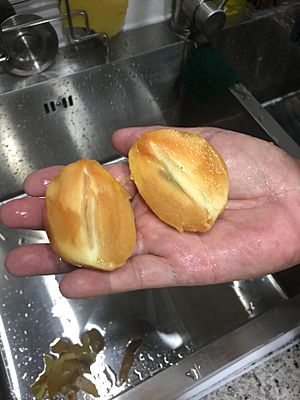Sapodilla facts for kids
Quick facts for kids Manilkara zapota |
|
|---|---|
 |
|
| The flesh of a sapodilla fruit | |
| Scientific classification |
Manilkara zapota is a fruit tree. It is part of the Sapotaceae family. People often call it the Sapodilla or Sapota. This tree originally comes from southern Mexico, Central America, and the Caribbean. It is famous for its delicious fruit, which tastes very sweet and malty, a bit like a pear.
Contents
What is Sapodilla?
The sapodilla tree is an evergreen tree. This means it keeps its leaves all year round. It can grow quite tall, sometimes reaching up to 30 meters (about 100 feet). The tree produces a milky sap called latex. This sap was once very important for making chewing gum.
The Sapodilla Fruit
The fruit of the sapodilla tree is round or oval. It has a rough, brown skin. Inside, the flesh is soft and yellowish-brown. It has a sweet, unique flavor. Some people say it tastes like brown sugar, caramel, or pear. The fruit usually has a few black, shiny seeds inside. You can eat the fruit fresh. It is also used in desserts, smoothies, and jams.
Where Sapodilla Grows
Sapodilla trees love warm, tropical climates. They grow best in places with lots of sunshine and rain. Besides its native home in Mexico and Central America, sapodilla is now grown in many other tropical countries. These include India, the Philippines, Thailand, and Florida in the United States.
Uses of the Sapodilla Tree
The sapodilla tree is valuable for more than just its fruit. Different parts of the tree have been used for many purposes over time.
Chicle: Natural Chewing Gum
One of the most interesting uses of the sapodilla tree is its sap. This milky liquid is called chicle. For a long time, chicle was the main ingredient in natural chewing gum. Workers would make cuts in the tree's bark. The chicle would then drip out and be collected. This natural gum was very popular before synthetic (man-made) gums became common.
Wood and Other Uses
The wood of the sapodilla tree is also very strong and durable. It is often used for making furniture, flooring, and other wooden items. Because the tree is so hardy, it can also be planted to help prevent soil erosion. This means it helps keep the soil from washing away, especially on hillsides.
Images for kids
See also
 In Spanish: Chicle para niños
In Spanish: Chicle para niños



